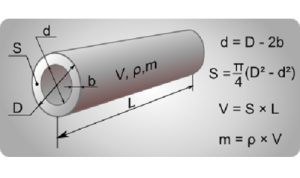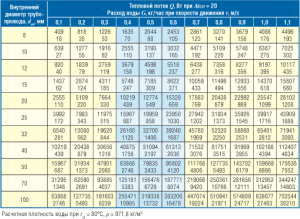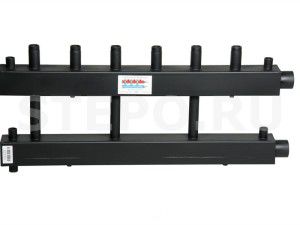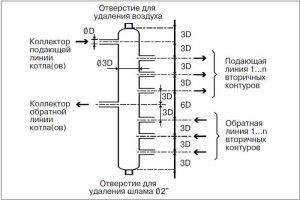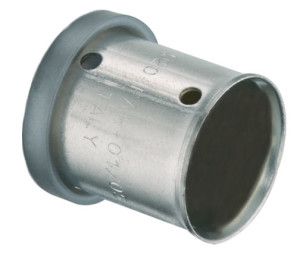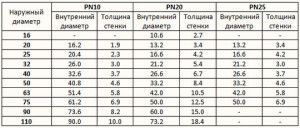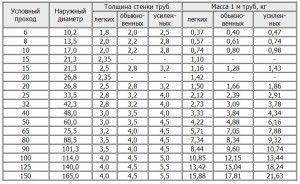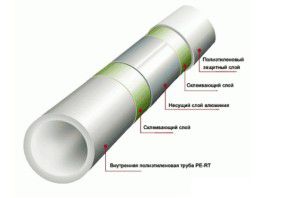The correct design of the heating system is to take into account all possible factors of influence on its efficiency. In addition to the correct selection of the main components, boiler, radiators, safety groups, the cross-section of the mains should be correctly calculated. To do this, you need to know the optimal diameter of the heating pipes: how to choose and calculate it yourself?
Difficulties in choosing the diameter of the heating pipes
It would seem - the choice of the diameter of the pipes for heating a private house is not a difficult task. They should only ensure the delivery of the coolant from the source of its heating to heat supply devices - radiators, batteries.
But in practice, an incorrectly selected diameter of the heating manifold or supply pipe can lead to a significant deterioration in the operation of the entire system. This is due to the processes that occur during the movement of water along highways. To do this, you need to know the basics of physics and hydrodynamics. In order not to go into the jungle of accurate calculations, you can determine the main characteristics of heating, which directly depend on the cross-section of the pipelines:
- Coolant speed. It affects not only the increase in noise during the operation of the heat supply, but also is necessary for the optimal distribution of heat among the heating devices. Simply, the water should not have time to cool to the minimum level when reaching the last radiator in the system;
- Coolant volume. So, the diameter of pipes with natural circulation of heating should be large in order to reduce losses due to friction of the liquid on the inner surface of the pipeline. However, along with this, the volume of the coolant increases, which entails an increase in the cost of heating it;
- Hydraulic losses. If the system uses different diameters of plastic pipes for heating, then a pressure difference will inevitably occur at their junction, which will lead to an increase in hydraulic losses.
How to choose the diameter of the pipe for heating, so that upon installation you do not have to redo the entire heating system because of the extremely low efficiency? First of all, you should perform the correct calculation of the cross section of the highways. To do this, it is recommended to use special programs and, if desired, manually check the result yourself.
At the junction, the diameters of the polypropylene pipes for heating are reduced due to the overlay. The reduction in cross-section depends on the degree of heating during soldering and compliance with the installation technology.
The procedure for calculating the cross section of heat supply lines
Before calculating the diameter of the heating pipe, it is necessary to determine their basic geometric parameters. To do this, you need to know the main characteristics of the highways. These include not only performance, but also size.
Each manufacturer indicates the value of the pipe section - diameter. But in fact, it depends on the wall thickness and the material of manufacture. Before acquiring a certain model of pipelines, you need to know the following features of the designation of geometric dimensions:
- The calculation of the diameter of polypropylene pipes for heating is done taking into account the fact that manufacturers indicate the outer overall dimensions. To calculate the useful section, it is necessary to subtract two wall thicknesses;
- For steel and copper piping, internal dimensions are given.
Knowing these features, you can calculate the diameter of the heating manifold, pipes and other components for installation.
When choosing polymer heating pipes, it is necessary to clarify the presence of a reinforcing layer in the design. Without it, when exposed to hot water, the line will not have the necessary rigidity.
Determination of thermal power of the system
How to choose the diameter of pipes for heating and should it be done without calculated data? For a small heating system, you can do without complex calculations. It is only important to know the following rules:
- The optimal diameter of pipes with natural circulation of heating should be from 30 to 40 mm;
- For a closed system with forced movement of the coolant, smaller pipes should be used to create optimal pressure and water flow rate.
For accurate calculation, it is recommended to use the program to calculate the diameter of the heating pipes. If they are not, you can use approximate calculations. First you need to find the thermal power of the system. To do this, use the following formula:
Q = (V * Δt * K) 860
Where Q - calculated heating power, kW / h,V - volume of the room (house), m³,Δt - the difference between the temperatures in the street and indoors, ° C,TO - the estimated coefficient of heat loss at home,860 - the value for translating the obtained values into an acceptable format of kW / h.
The greatest difficulty in the preliminary calculation of the diameter of the plastic pipes for heating is caused by the correction factor K. It depends on the thermal insulation of the house. It is best taken from the table.
| Coefficient K | The degree of thermal insulation of the building |
| 3-4 | Minimal thermal insulation |
| 2-2,9 | Minimum insulation of the facade - brick lining. |
| 1-1,9 | Average thermal insulation |
| 0,6-0,9 | High-quality insulation of the house, modern windows and doors are installed |
As an example of calculating the diameters of polypropylene pipes for heating, you can calculate the required heat output of a room with a total volume of 47 m³. In this case, the outdoor temperature will be -23 ° C, and indoors - + 20 ° C. Accordingly, the difference Δt will be 43 ° C. The correction factor is taken to be 1.1. Then the required thermal power will be.
Q = (47 * 43 * 1.1) /860=2.585 kW / h
The next step in choosing the diameter of the pipe for heating is to determine the optimal speed of the coolant.
The calculations presented do not take into account the correction for the roughness of the inner surface of the lines.
Water velocity in pipes
The optimum heat transfer pressure in the mains is necessary for an even distribution of thermal energy over radiators and batteries. For the correct selection of the diameters of the heating pipes, the optimal values of the speed of water advancement in the pipelines should be taken.
It is worth remembering that if the intensity of the coolant is exceeded, extraneous noise may occur in the system. Therefore, this value should be equal to from 0.36 to 0.7 m / s. If the parameter is less, additional heat losses will inevitably occur. If it is exceeded, construction of noise will appear in pipelines and radiators.
For the final calculation of the diameter of the heating pipe, use the data from the table below.
Substituting into the formula for calculating the diameter of the heating pipe in the previously obtained values, it can be determined that the optimal pipe diameter for a particular room will be 12 mm. This is just an estimate. In practice, experts recommend adding 10-15% to the obtained values. This is because the formula for calculating the diameter of the heating pipe may change due to the addition of new components to the system.
For accurate calculation, you will need a special program to calculate the diameter of the heating pipes. Similar software systems can be downloaded in a demo with limited calculation capabilities.
Calculation of the heating manifold and mounting sleeves
The above calculation technology can be applied to all types of heat supply - single pipe, double pipe and collector. However, for the latter, it is necessary to make the correct calculation of the diameter of the heating manifold.
This heating element is necessary for the distribution of the coolant in several circuits. In this case, the calculation of the correct diameter of the heating manifold is inextricably linked with the calculation of the optimal section of the pipeline. This is the next stage in the design of a heat supply system.
To calculate the diameter of the heating manifold, you must first calculate the cross-section of the pipes according to the above scheme. Then you can use a fairly simple formula:
M0 = M1 + M2 + M3 + M4
Where M0 - the desired diameter of the collector,M1, M2, M3, M4 - diameters of the connected pipelines.
When determining the height and the optimal distance between the nozzles, the principle of "three diameters" is applied. According to him, the remoteness of the pipes on the structure should be 6 radii each. The total diameter of the heating manifold is also equal to this value.
But besides this component of the system it is often necessary to apply additional ones. How to find out the diameter of the sleeve for heating pipes? Only by performing a preliminary calculation of the cross section of highways. In addition, you need to consider the thickness of the walls and the material of their manufacture. The design of the sleeve, the degree of its thermal insulation will depend on this.
The value of the diameter of the sleeve for heating pipes is affected by the material of the wall, as well as the pipe. It is important to consider the possible degree of expansion when heating the surface. If the diameters of the plastic heating pipes are 20 mm, then the same parameter for the sleeve should be at least 24 mm.
The installation of the sleeve must be done on a cement mortar or similar non-combustible material.
Additional data for calculating the diameter of the heat supply pipes
After choosing the diameter of the pipes for heating a private house, you need to choose their manufacturing material correctly, and also take into account the features of the heating system. This parameter is affected by the layout of the lines, as well as the number of shutoff and control valves.
In addition to knowing the diameter of pipes in heating with natural circulation, it is necessary to take into account the height of the accelerating riser and choose the right size for its cross section. It should be at a minimum height of 1.5 relative to other heat supply elements. To increase the velocity of the coolant, the diameter of the polypropylene pipes used in the design of the booster must be one size larger than that of the main line.
It is also important to consider the wall thickness of pipelines. It depends on the material of manufacture and can vary from 0.5 mm (steel) to 5 mm (plastic). The choice of pipe diameter for the heating system of a private house is influenced by the material of manufacture. So, it is recommended to install plastic lines for systems with forced circulation. Their inner diameter can vary from 10 to 30 mm. More information about the wall thickness of polymer pipes for heating can be found in the table.
For steel models, it is necessary to take into account not only their geometric dimensions, but also the mass. It directly depends on the wall thickness. In programs for calculating the diameter of heating pipes, there must necessarily be a function for calculating the specific gravity of 1 m. steel line.
Knowing these additional characteristics, you can make the most accurate calculation of the parameters of the heating system, including the correct selection of the diameters of the heating pipes.
If you need to calculate only the cross-section of heat-conducting mains, you can use free demo versions of professional programs.
Material for manufacturing heating pipes
In addition to the correct choice of pipe diameters for heat supply, you need to know the characteristics of their manufacturing material. This will affect the heat loss of the system, as well as the complexity of installation.
It should be remembered that the calculation of the diameters of the heating pipes is carried out only after selecting the material of their manufacture. Currently, several types of pipelines are used to complete the heat supply systems:
- Polymer. They are made of polypropylene or cross-linked polyethylene. The difference lies in the additional components added during the manufacturing process. After calculating the diameter of the polypropylene pipes for heat supply, you need to choose the correct thickness of their wall. It varies from 1.8 to 3 mm, depending on the parameters of the maximum pressure in the lines;
- Steel. Until recently, this was the most common heating arrangement. Despite its more than good strength characteristics, steel pipes have a number of significant drawbacks - complicated installation, gradual surface rusting and increased roughness. Alternatively, pipes made of stainless steel can be used. One of their value is an order of magnitude higher than the “blacks”;
- Copper. According to technical and operational characteristics, copper pipelines are the best option. They are characterized by sufficient stretching, i.e. if water freezes in them, the pipe will expand for some time without loss of tightness. The disadvantage is the high cost.
In addition to correctly selected and calculated pipe diameters, you need to determine the method of their connection. It also depends on the material of manufacture. For polymers, a sleeve connection is used by welding or on an adhesive basis (very rarely). Steel pipelines are mounted using arc welding (best quality joints) or threaded method.
In the video material, you can see an example of calculating the diameter of the pipes depending on the optimal flow rate of the coolant:

